Luxury Travel Review

Portable WiFi hotspot handy to stay connected on safari
Article and photos by Gary Cox
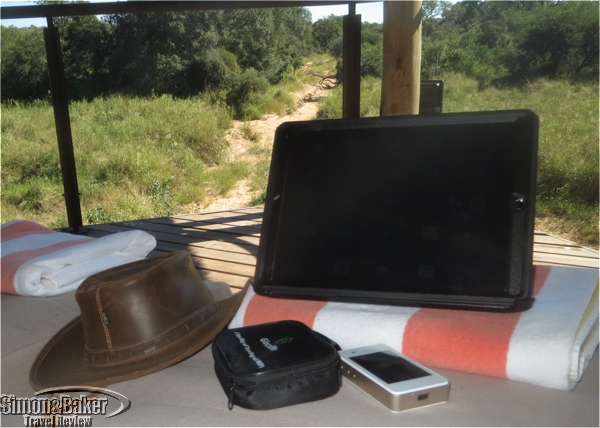
Lounging on the porch with my iPad and the RoamingMan hotspot in the Thornybush Nature Reserve
On our most recent safari trip to South Africa we took a 353 gram RoamingMan (RoamingMan, Ucloudlink (America), Ltd, 119B Hester St, New York, NY 10002, www.roamingman.com, supportus@roamingman.com) hotspot device, to connect to the internet with our electronic devices (laptop and tablet) using the nearest and strongest cellphone signals. Although most of the lodges where we stayed offered complimentary WiFi, many of the networks were unsecured, allowing anyone with a WiFi card and some basic skills to become an amateur eavesdropper. Others required a password known by many staff and guests. Because cellular 4G networks are encrypted and require expensive specialized equipment to hack we often felt safer using our personal hotspot than the property’s WiFi. The RoamingMan device also provided internet access while we were transferring between properties, which was often a good time for us to go online and check emails.
Operating the device was easy. We turned it on and connected to the WiFi using the password on the screen. The 4G connection was fast enough to be useful for web browsing and emails. The hub, manufactured in China, was a little larger than a deck of cards and solidly built with a few simple controls. It weighed about eight ounces, came with a charging cable and was packed in a zippered case. The internal battery, rated to last up to 15 hours, held its charge when powered off for several days.
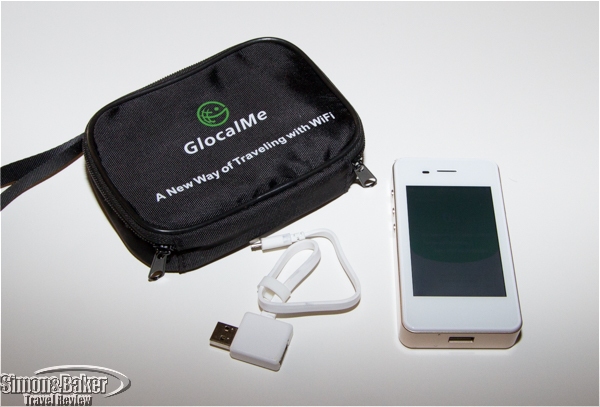
The RoamingMan WiFi device came with a charging cable and a zippered case.
Almost every device we travel with requires USB power to charge these days, and the charging cable had a pass through plug on the back, allowing multiple devices to charge from a single adapter. It performed double duty, as a WiFi hotspot and a standby battery pack for emergency charges, able to charge a cell phone or mp3 player in a pinch, a feature that came in handy a time or two.
RoamingMan rented the small Android based hub for a daily flat rate with unlimited data. The device we used was a customized version of the GlocalMe, with support provided by RoamingMan instead of the manufacturer. The WiFi hub used a cloud based SIM technology to allow global roaming, supposedly finding the best rate and connection, but what was critical to us is that it mostly worked well in South Africa. There was one day when we drove through the mountains in the Blyde River Canyon where reception was poor, but that was the exception. Connectivity was good in most places we tried.
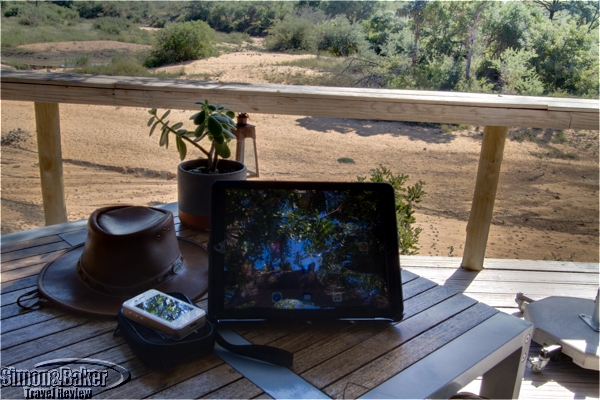
While sitting by the dry riverbed at The River Lodge I connected to the internet with the RoamingMan hotspot and my tablet
Delivery was of the hotspot unit stateside was efficient and convenient. The company shipped the device before we departed and activated it on the date we requested. When we returned home, we packed it into the shipping box, placed on the return label they provided and dropped it off a local UPS pickup spot. We were glad to have it with us, for the extra security of using cellular data without the challenges of figuring out the costs. This is one simple to use device that we will consider packing for future international adventures.
Anna Maria Island impressions
By Elena del Valle
Photos by Gary Cox
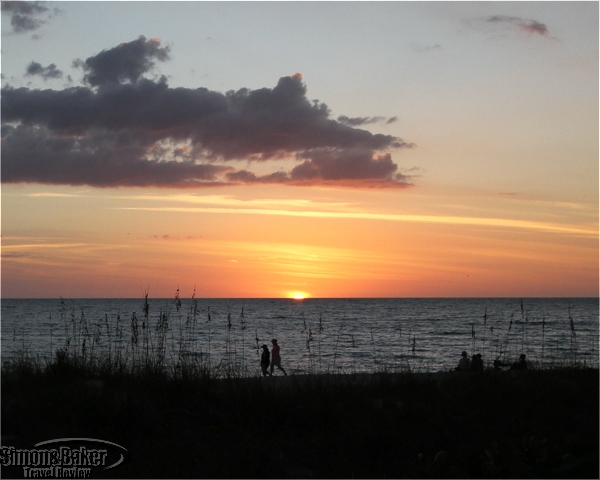
Sunset over the gulf on Anna Maria Island
For some reason I had it in my mind that Anna Maria Island, an island with three distinct municipalities off the coast of Bradenton, Florida, would be a sleepy relaxed vacation place. Sleepy it was not. We visited during the low season and it was bustling with people (and some pets), especially on the wide white sand beach. While there was a permanent resident population (1,814 residents and 1,098 single family homes in the City of Anna Maria, according to its website) the island was highly touristy. The density of houses and number of new construction projects surprised us.
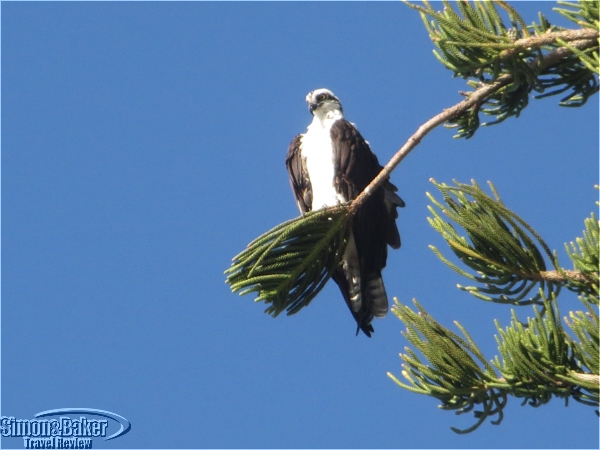
An osprey caught our attention while we were walking on the beach
Although we walked the length of the beach from north to south and south to north, we spent the majority of our time in the north end of Holmes Beach and the City of Anna Maria. Both were more residential than commercial as well as quieter and less crowded, by comparison, than the south end of Holmes Beach and Bradenton Beach. Visitors and residents made their way around the island on foot for short distances. Cars, golf carts and a complimentary trolley (a full size air conditioned bus when we were there) with frequent stops over most of the island shared the few roads. A favorite option was to ride the trolley to the end of the line on the southern tip of Anna Maria Island, and walk along the beach all the way north or to our beachfront rental. We also walked south and returned via the trolley, but it meant facing the hot sun for most of the walk south so we preferred riding the trolley south and walking north.
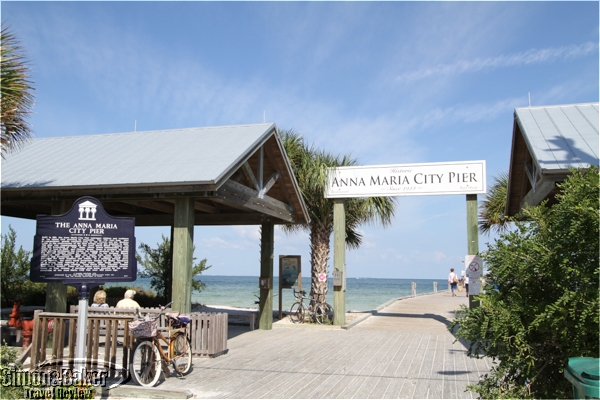
The Anna Maria City Pier was popular
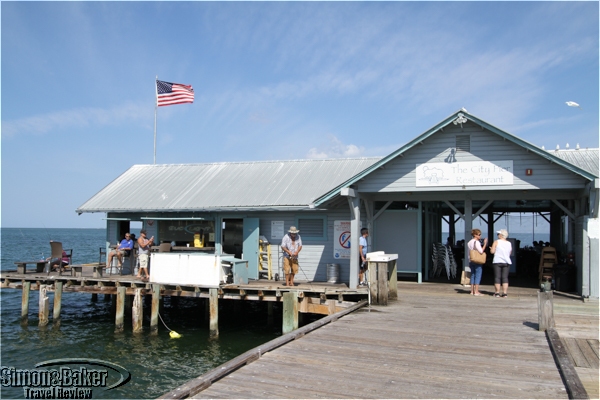
The Anna Maria City Pier Restaurant surrounded by people fishing
In the City of Anna Maria, we liked Pine Avenue for window shopping. The Anna Maria City Pier, on the east end of Pine Avenue, was fun of people watching and strolling. From the pier we could see the mainland in the east. And below the surface the water was so clear we could see fish and pale sand at the bottom. At the end of the pier, people with a variety of regional accents, some speaking European languages, fished contently. We especially appreciated that the entire city was a bird sanctuary.
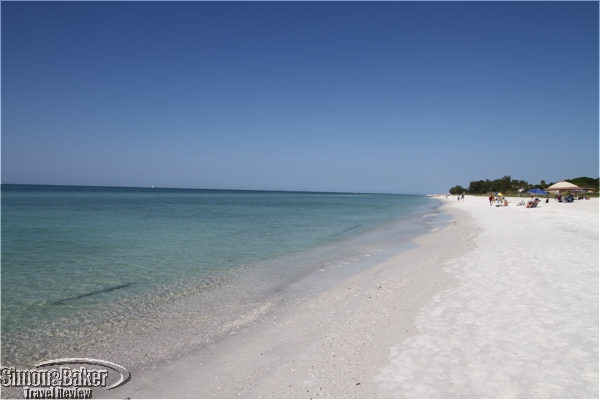
The water was clear and inviting
For a sweet treat there was Hometown Desserts (507B Pine Avenue, Anna Maria, Florida 34209, +1 941 896-3167), a tiny shop off Pine Avenue, the main road, where I bought cookies, key lime pie, cup cakes and coconut macaroons (a gluten free option). For an alfresco lunch we liked The Waterfront Restaurant and Craft Bar (111 South Bay Boulevard, Anna Maria, Florida 34216, +1 941-778-1515, https://thewaterfrontrestaurant.net/, info@thewaterfrontrestaurant.net), across the street and half a block south from the pier. It offered friendly service and seating indoors and on a shady outdoor deck facing the bay. It was popular on weekends. We had to wait an hour Friday afternoon for a table on the covered terrace.
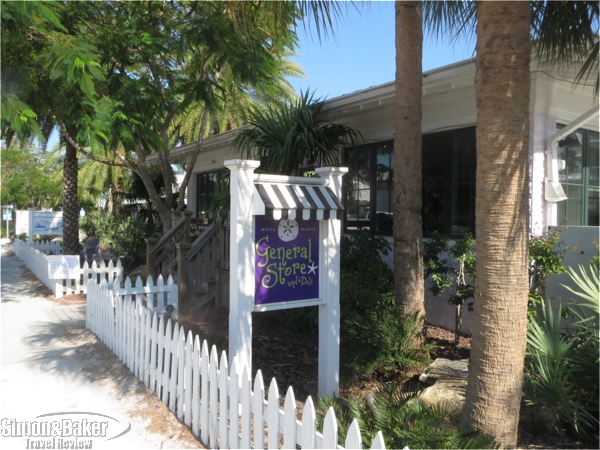
The local grocery and deli on Pine Avenue in the City of Anna Maria
In general, the firm white powdery beach was our favorite feature on the island. In the predawn hours and as the sun was rising many people walked and jogged along the shore. Despite the wide beach it felt crowded at times yet it was pleasant and surprisingly clean. As the sun advanced in the sky more beach lovers arrived with chairs, umbrellas and snacks to settle in for a several hours. Few went in the clear chilly water. Some collected seashells or made sandcastles. Later as the sun waned a batch of sun lovers made their way to the seashore to catch a glimpse of the sunset. Waiting for the golden orb to dip beyond the horizon became one of our daily treats.
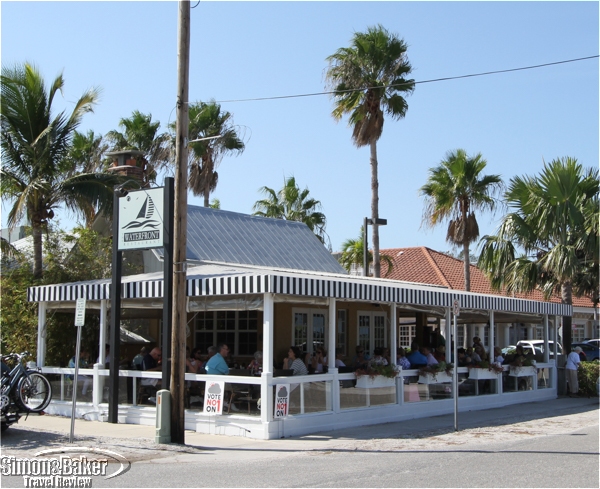
The Waterfront Restaurant and Craft Bar was a favorite for alfresco dining
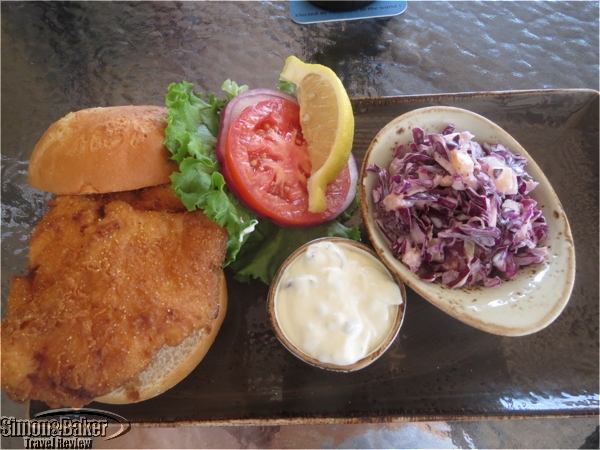
The grouper sandwich
Our stay on Anna Maria Island was pleasant and worth repeating. I would return to the City of Anna Maria and Holmes Beach for its pretty white sand beach, relaxed resort style ambiance, upscale accommodations and natural setting.
Photo book captures Paris metro history from 1900 to present
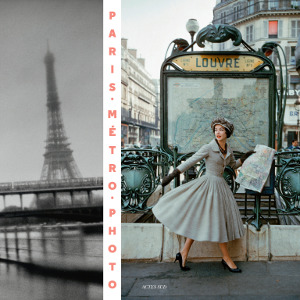
Paris Metro Photo*
For lovers of the Paris metro and transit fans Actes Sud recently published Paris Metro Photo ($55), a 406-page hardcover volume featuring some 250 photos of the heyday of the Paris metro. It has more than a century of photographic documents and photos from Robert Doisneau, Henri Cartier-Bresson, Brassaï, Edouard Boubat, Izis (Israëlis Bidermanas), Francois Kollar, Willy Ronis, Robert Capa, William Klein and Johan Van der Keuken among others.
The book features varied genres and photographic practices, including photojournalism, photo stories, street photography, fashion photography, architectural photography and industrial photography all centered around the history of the development of the Paris metro. In 1900, when the first metro rolled from west to east across Paris, from Porte Maillot to Porte de Vincennes it quickly became a cultural symbol of France, Art Nouveau and urban technological innovation. By then photography had been around for five decades and technological advances had made light cameras possible.
The book is divided into twenty year periods beginning in 1900. Each photo is accompanied by a description and date. The photo sources are public and private such as art galleries, AKG Images, Getty Images, libraries, and museums in France, The Netherlands, Scotland, Switzerland, and the United States. The book was published as a project of the Paris RATP (Régie Autonome des transports Parisiens) public transport authority. In addition to the photos there introductory statements by Anne-Marie Garat and Julien Faure-Conorton (he selected the photography) as well as a brief description for each twenty year section of photography.
*Photo courtesy Actes Sud
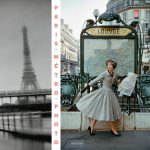
Click to buy Paris Metro Photo
Highlights of our Black Forest Highlands visit
By Elena del Valle
Photos by Gary Cox
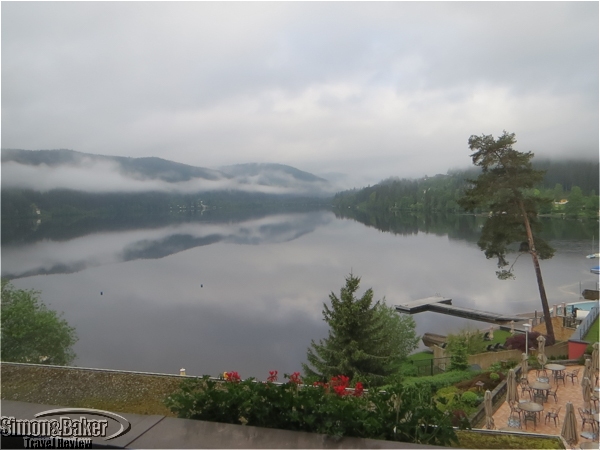
A typical dreary day by Lake Titisee during our visit
We planned our week long trip to the Black Forest Highlands in Germany months in advance with the expectation that a spring itinerary would reward us with dry and sunny weather. Instead it our visit in June 2016 was far wetter, colder and foggier than we had anticipated. It rained on and off most of the day every day during our whole stay in the area, forcing us to revise our plans entirely. In lieu of trekking on mountain tops and cable cars we spent our days in our hotel room waiting for the rain to stop or remained indoors, dining, in museums, and churches for the duration of our visit.
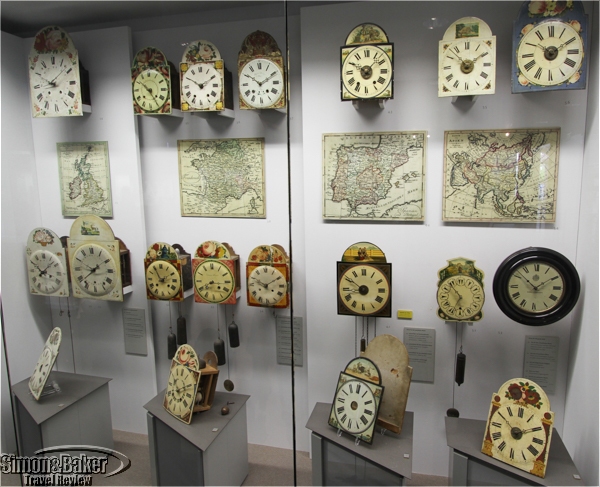
The clock museum featured displays of clock history
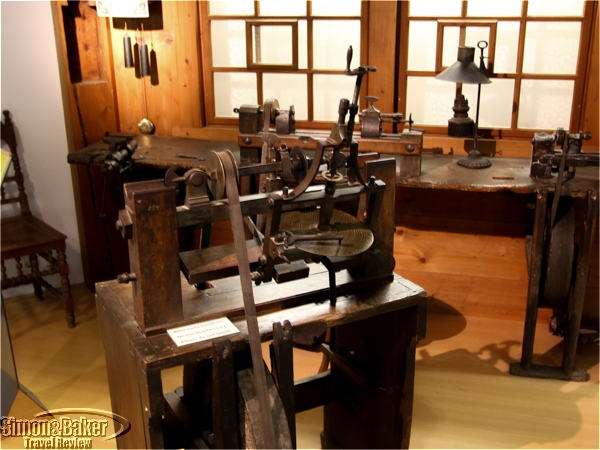
Tools used to automate the creation of the gears and wheels were featured
We replaced nearly all our outdoor activities with indoor ones. The two lane mountain roads, slick from the rain and filled with impatient drivers, did nothing to improve the situation. In the end, we made the most of the situation, exploring as best as possible in moments of respite from the constant showers. We seldom encountered English speakers or materials in English, making it necessary for us to rely on our guide frequently to translate menus at restaurants and information sheets at attractions.
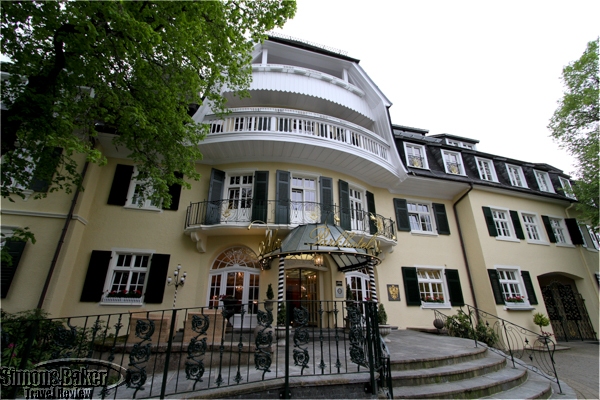
The Parkhotel Adler in Hinterzarten was a favorite for its luxury facilities and spa
From the airport we drove to the Parkhotel Adler in Hinterzarten. It was the most luxurious of the properties we visited that trip. I spent time at Hoffmann Beaute & Physiontherapie, its serene spa. Because of the cool temperatures and showers I was thankful for the property’s underground hallways that connected its facilities and provided us indoor access to the hotel spa and restaurants in adjacent buildings.
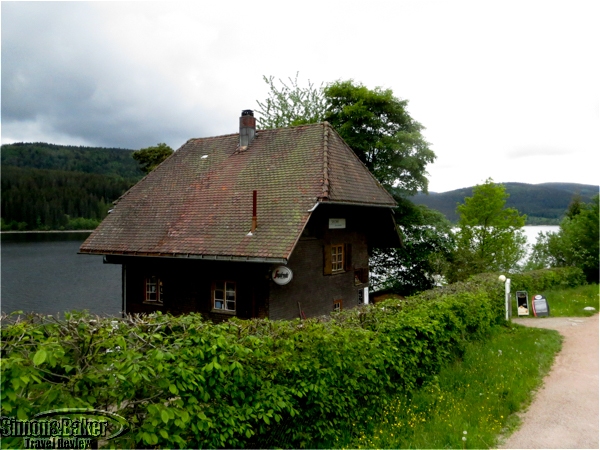
The lake fronting Seecafé in Schluchsee
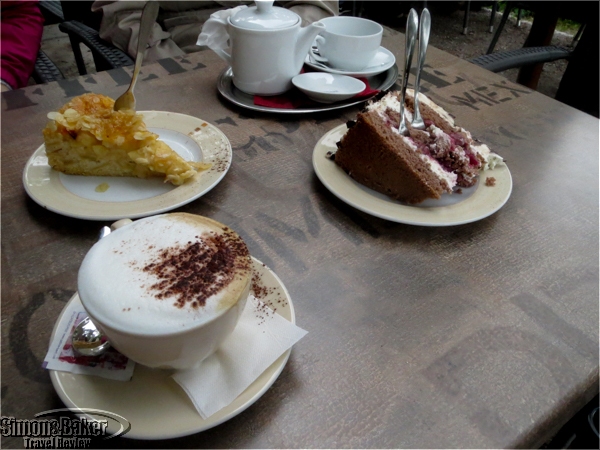
We had Black Forest cake, strudel cake and cappuccino by the lake
The first attraction we visited was the Deutsches Uhrenmuseum (German Clock Museum at Robert-Gerwig-Platz d-78120 Furtwangen, +49 7723-920 2800, deutsches-uhrenmuseum.de) northeast of Freiburg. It was a fun way to spend the morning and learn about the history of clock making in Germany.
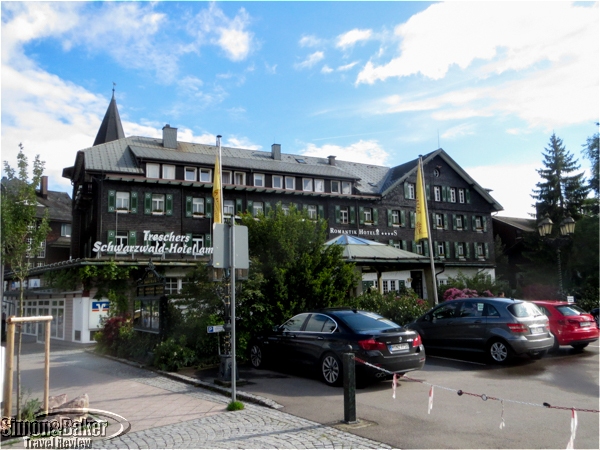
We spent the weekend at the popular Treschers Schwarzwald Romantic Hotel
One afternoon, to satisfy our sweet tooth we stopped at the Seecafé (Im Wolfsgrund 26, 79859, Schluchsee, +49 76 56/98 88 97), where we indulged in hot beverages and huge slices of regional specialties such as Black Forest chocolate cake. Despite the chilly temperatures we enjoyed the Schluchsee lakeside setting and terrace seating until a steady flow of raindrops forced us to leave.
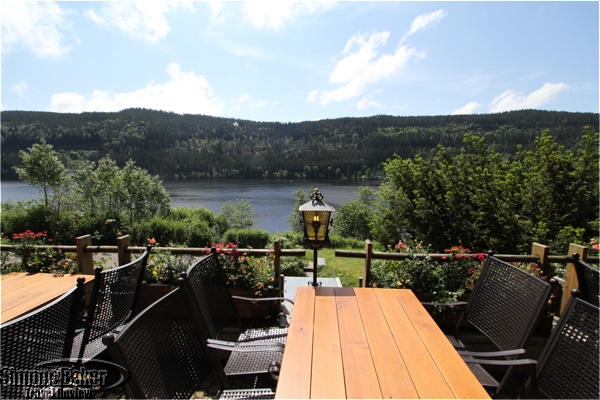
We were delighted with our first sunny hour from the patio at Boutique-Hotel Alemannenhof
In the Lake Titisee area we stayed at two family owned properties. We spent the weekend at the popular, lake fronting Treschers Schwarzwald Romantic Hotel (see Our weekend stay at Black Forest lake front hotel with spa) with a spa in the highly touristy town of Titisee. When our rental apartment plans fell through the friendly owners and staff at the charming and lovingly built Boutique-Hotel Alemannenhof squeezed us in at the last minute without hesitation. The hotel, the Drubba Monument Shopping stores on the pedestrian street in Titisee, and the Hofgut Sternen hotel and adjacent shops were the property of the enterprising Drubba Family. It was at one of their shops where we watched a demonstration about the making of the famous cuckoo clocks. At another we caught the end of a glassblowing demonstration. Their hillside property was a favorite for its Lake Titisee views and foodie orientation.
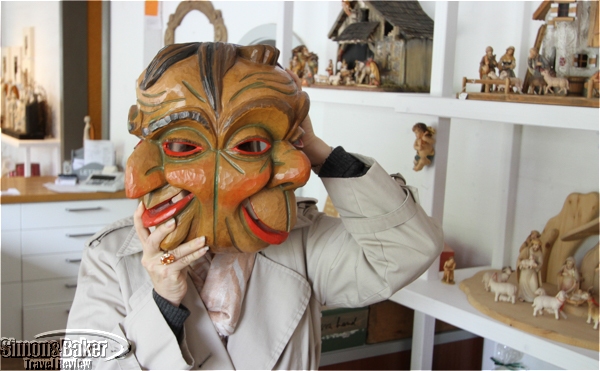
One of the hand-carved carnival masks at Holzmasken Stiegeler in Grafenhausen
In Grafenhausen, we liked the hand-carved carnival masks at Holzmasken Stiegeler (see Black Forest shop carried on with wood carved mask tradition). In Grafenhausen-Rothaus, we visited Hüsli or small house (79865 Grafenhausen-Rothaus, Am Hüsli 1 im Naturpark Südschwarzwald, + 49 77 48/212, www.hüsli-museum.de), a folk art museum dating back to 1912 when actress Helene Siegfried built a summer home from second-hand materials. We also toured the Rothaus (Badische Staatsbrauerei Rothaus AG, Rothaus 1, 79865 Grafenhausen-Rothaus, +49 7748/522-0, www.rothaus.de, info@rothaus.de) brewery museum, a modern facility with self-guided tours, where we sampled locally produced beer and bought souvenirs at the small shop.
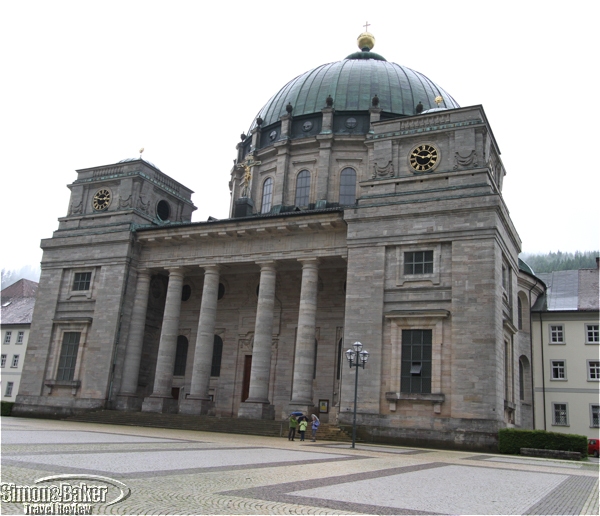
St. Blasien Cathedral, a lovingly maintained structure 36 meters wide and 62 meters high
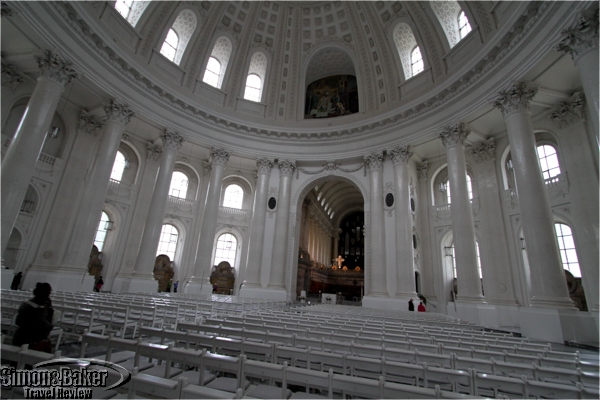
The interior of St. Blasien Cathedral
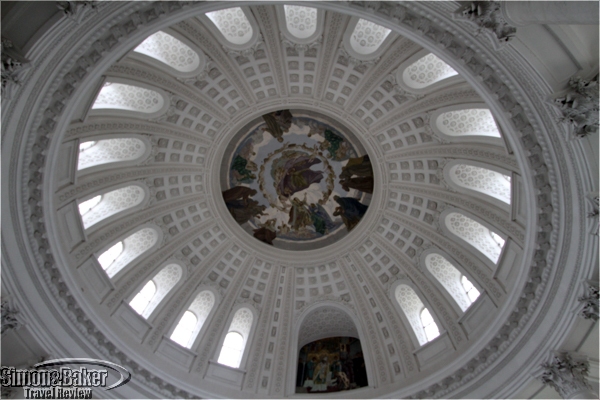
The St. Blasien Cathedral cupola
We visited several churches while in the Black Forest Highlands. Salient among them for sheer size and the determination of its builders was St. Blasien Cathedral, a pretty and lovingly maintained structure 36 meters wide and 62 meters high. The early classical cupola is the largest of its kind north of the Alps.
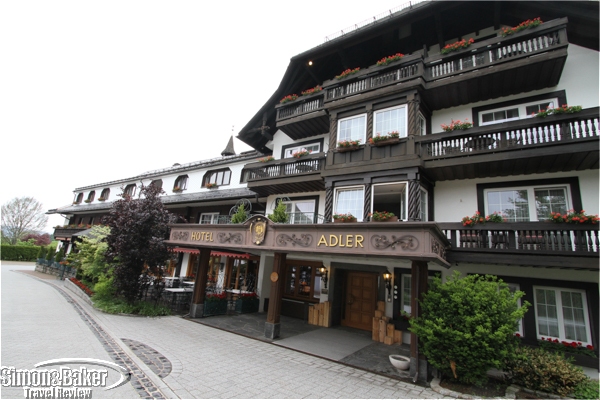
Our final nights were at the Hotel Adler in Häusern
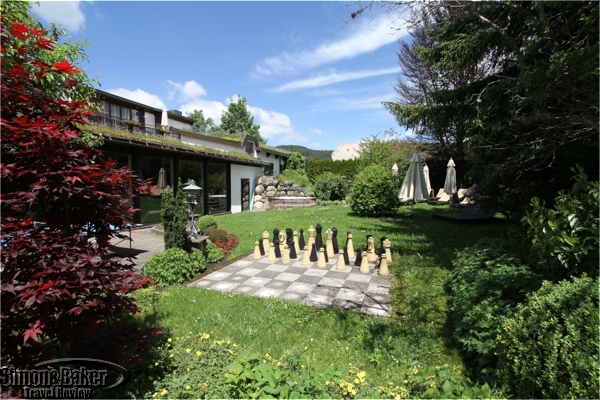
The sun made an appearance on our last afternoon in the Black Forest
Our final nights were at the Hotel Adler in Häusern, where we dined at the hotel’s gourmet restaurant (see Dinner at Black Forest Highlands gourmet restaurant). We would recommend the Black Forest Highlands to friends who speak German or don’t mind seeking translations, like moderate luxury in a heavily touristy area with authentic regional cuisine, enjoy mountainous landscapes and the outdoors, and are able to change plans in a hurry if the weather turns ugly.
Cruising Through Highlights of the British Museum
Article and photos by Scott S. Smith
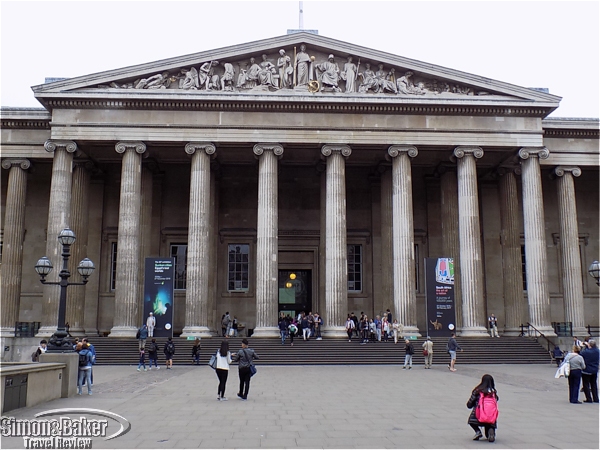
London’s vast British Museum is the oldest public museum in the world
My wife and I thought we could run through a refresher on London’s British Museum when we visited for the second time in September 2016 (Great Russell Street, +44 020 7323 8000, www.britishmuseum.org, info@britishmuseum.org). We had taken a full two days 35 years before when we were last there, but figured four hours would be enough to hit the highlights. Relying on the invaluable DK Eyewitness Travel Guides London, with additional tips from Rick Steves’ Pocket London and checking the website, we boiled down the list to just the must-see-agains and some we had overlooked or which had not been on display (we belatedly discovered that only one percent of its 50,000 items are exhibited at any one time). Despite the name, this is really the greatest museum in the world on the history of the ancient world, thanks to plundering by colonial officials who had the classical education to appreciate what they brought back. As if that weren’t enough, it also has artifacts up to the present day. Established in 1753 to house a private collection, the main current building was completed in 1850, and the entire complex of 94 galleries on three levels occupies a total of 2.5 miles. We recommend to our friends visiting for the first time that they take one of the highlight tours and set aside at least one full day for the museum. To avoid crowds, we will visit weekday afternoons.
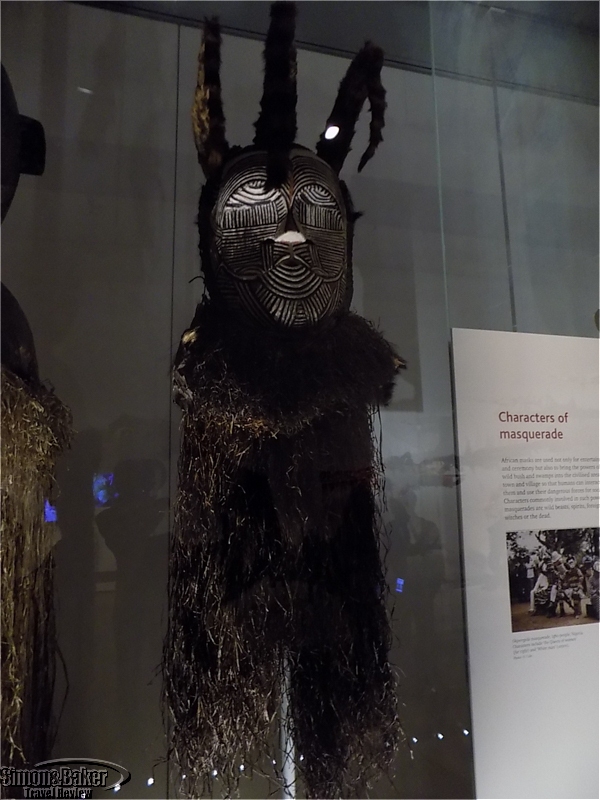
A 19th century priestly mask from the Songye people in the Democratic Republic of the Congo
We found the lower floor (basement) of the British Museum was overlooked because it is primarily devoted to Africa, while the other two floors had many world-class treasures. But African art has always been a favorite of ours when we go to any major museum of world culture. The African imagination has always struck us as astonishing, perhaps unleashed by its magical view of reality. The ritual masks, costumes, and statues are always better than anything we’ve ever seen near our home in West Hollywood, California, at the Halloween street parade, which is saying something (it draws half a million participants and spectators due to the creative contributions from movie professionals). This time, we particularly liked a multi-horned headdress for ancestral ceremonies from 19th century Nigeria and some famous bronze statues from the Kingdom of Benin.
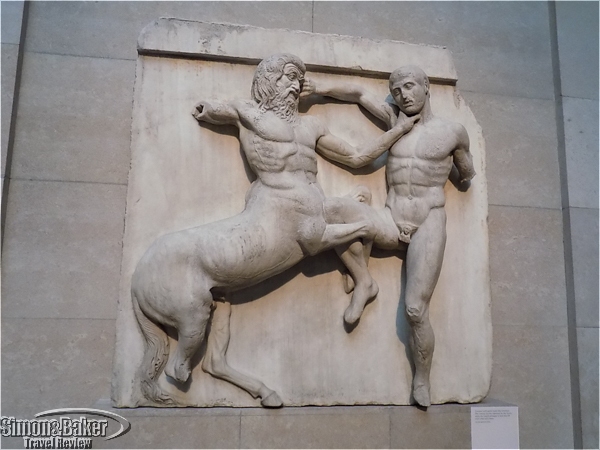
A Centaur and Lapith wrestle in a relief from the Parthenon
Back on the ground floor, we headed straight to the enormous room displaying the Elgin Marbles, décor from the Parthenon, the temple of Athena on the Acropolis in Athens, which the British brought back in 1816 and the Greeks have been trying ever since to get returned. Despite thousands of years of wear from exposure, they still showed the brilliant skills of the sculptors during the Golden Age of Greece (500-430 B.C.), the cultural supernova that led to the Renaissance and Western civilization (the best summary of their contribution is Edith Hamilton’s The Greek Way). We also saw many other gorgeous sculptures and ceramics from the Greeks and Romans in other galleries and on the upper floor.
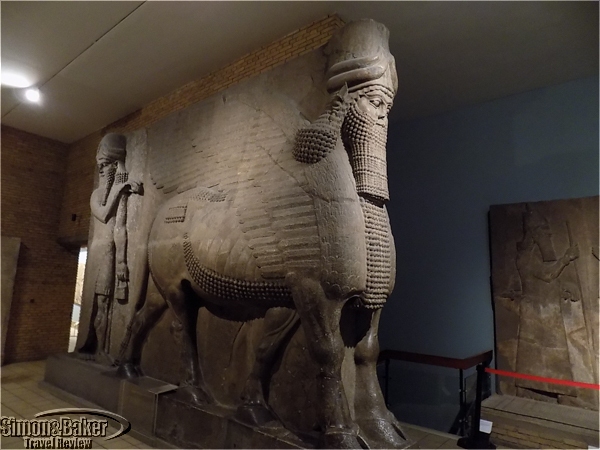
Human-headed winged bulls from the Palace of Sargon II at Khorsabad, Assyria (near Mosul, Iraq)
The ground floor also had much from the ancient Middle East, especially Assyria. There were several sets of enormous winged-bulls that guarded the palaces of Sargon II, who reigned 721-705 B.C. and according to the Bible took the northern 10 tribes of Israel into captivity (now referred to as the Ten Lost Tribes, they were said to have “gone north” after Assyria’s fall, but may have simply blended in with other peoples in the region). One famous relief depicted the royal sport of lion hunting, and there were artifacts from ancient Jericho and Islamic cultures. More from the Middle East, especially Iran, was on the upper floors, but we just breezed through it for lack of time. The collection for the Americas was confined to two modest rooms, but had some outstanding sculptures from ancient Meso-American peoples, such as the Zapotecs. As for the rest of the floor, having been to India and Japan, and having little interest in China, we skipped the Asian section.

Coffin of Egyptian incense bearer Denytenanum, Temple of Amun, Thebes (9th century B.C.)
The upper floor’s Egyptian section may be the world’s best outside of the Cairo Museum (which we’ve been to). It is world famous for having the Rosetta Stone, carved into which was a trilingual inscription that enabled the French to begin to decipher the hieroglyphics. It was hard to photograph through the glass and the writing is tiny, but there was a model nearby we could touch. Another outstanding item was the enormous statue of Ramesses II, the 13th century pharaoh many believe was the one who reluctantly let the Israelite slaves leave Egypt. There were also numerous mummies and painted coffins.
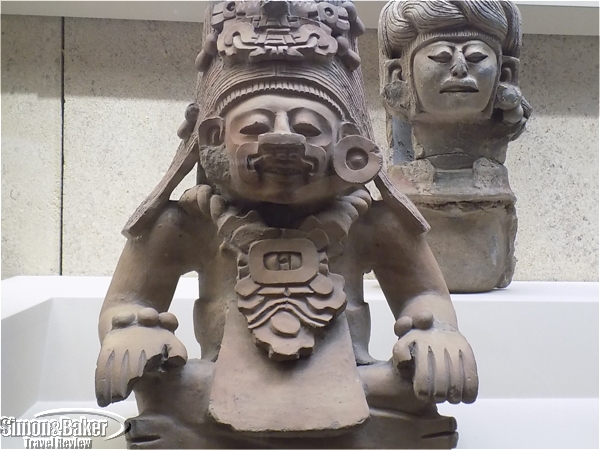
Zapotec funerary urn from Mexico from about 200 B.C.
The other primary section on the upper level we were interested in was for Britain, covering as far back as 10,000 B.C. The most striking item was the 2,000-year-old Lindow Man, who was sacrificed in a ritual way, his skin preserved in a peat bog in Cheshire. The other big draw was the burial of a 7th century A.D. Anglo-Saxon king in a ship filled with treasures at Sutton Hoo, East Anglia, discovered in 1936. Among the many notable items, which revolutionized understanding of the era, were a ceremonial helmet, a shield, gold jewelry, silver bowls, and a lyre, a harp-like instrument. Now that we have been reminded of how incredible the British Museum is, we will not take another 35 years to return and will give it the time it needs to be fully appreciated in the future. There is a reason it is the top tourist destination in Britain.
Black Forest shop carried on with wood carved mask tradition
By Elena del Valle
Photos by Gary Cox
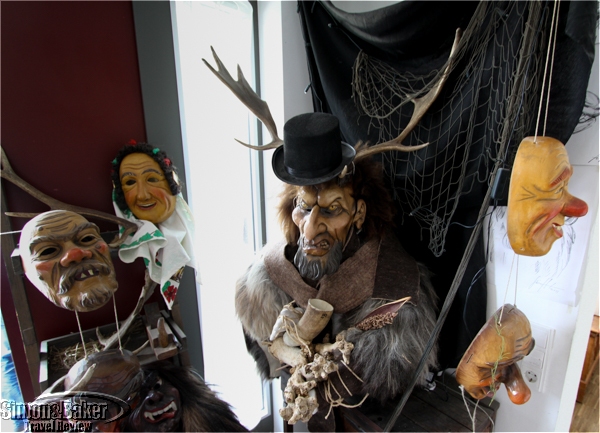
A display of masks at the shop entrance included a mythological figure with antlers.
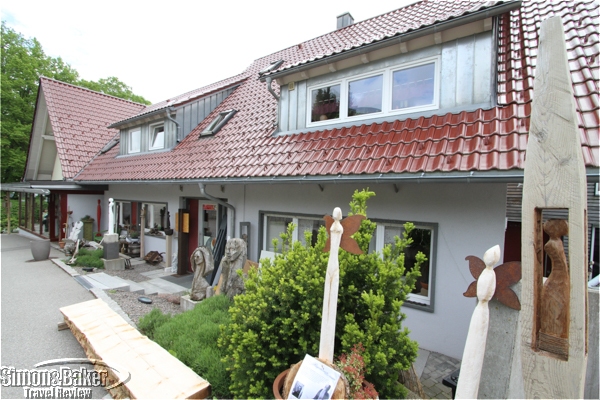
There were large sculptures outside the shop.
As a child Simon Stiegeler watched his parents carve traditional wood masks in their workshop in the Black Forest Highlands of Germany. As he grew older, he learned the craft in a woodcarving school in Austria and studied art in Freiburg. In time he adopted the family tradition. These days he spends his time at the Holzbildhauerei Stiegeler (Kirchsteig 5 79865, Grafenhausen, Black Forest Germany, + 49 07748-283, www.holzbildhauerei-stiegeler.de, www.holzmasken-stiegeler.de), a 100 square meter shop and workshop he owns with his family.
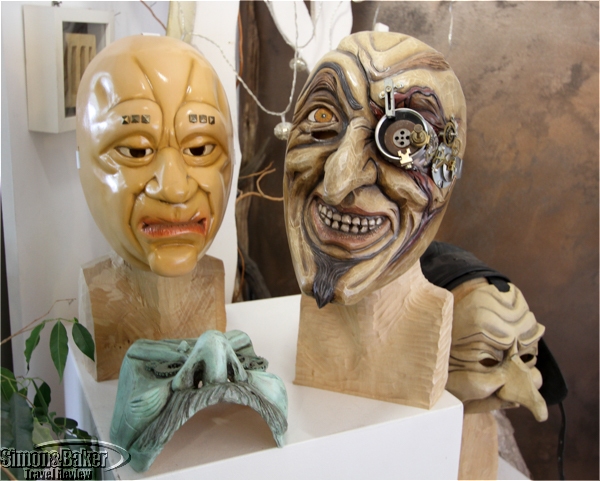
The masks varied from traditional designs of the region to modern adaptations.
That was where we met him, making schwäbisch alemannische fasnacht masks out of linden wood. There were witches, devils, animals, jesters and fools, some known by their local names from old words such as holzmaske, schemme, and larve. One of my favorite masks had a science fiction theme. Prices ranged from 50 to 1,200 euros.
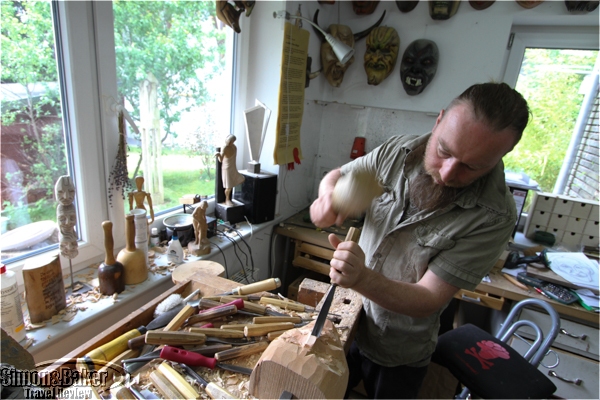
The artist at work
“The black forest has an very old tradition in making wood masks, times ago many farmers made wood masks in the long and cold wintertime,” he said when asked about the origin of his business. “I think we are one of the last profesionell (professional) family business whitch (which) exclusively make wooden masks.”
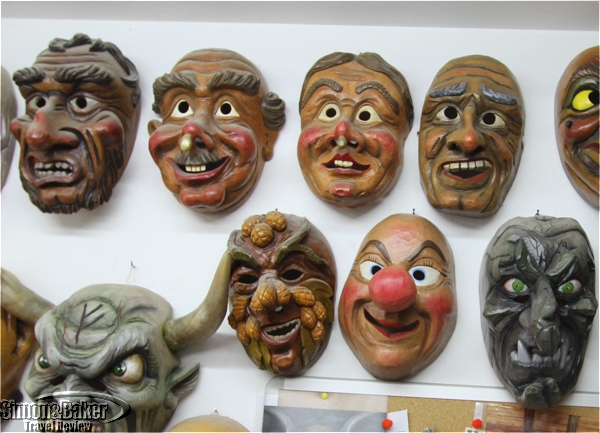
A variety of masks hung on the walls of the workshop.
He mainly makes masks for groups, collectors, actors and special orders, he explained during our visit. In 2010, he was invited to the World Expo in Shanghai, China to present the masks as a culture ambassador for Germany.
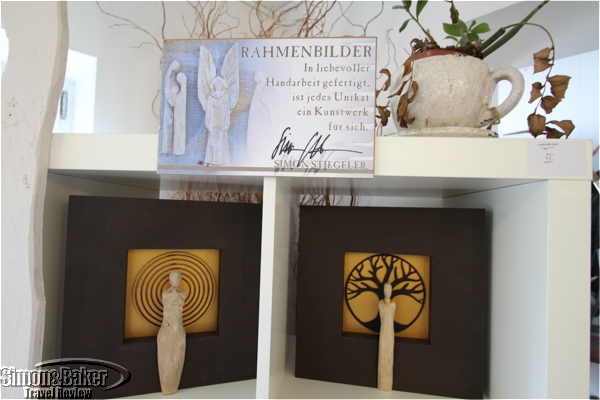
There were other wooden items in the shop.
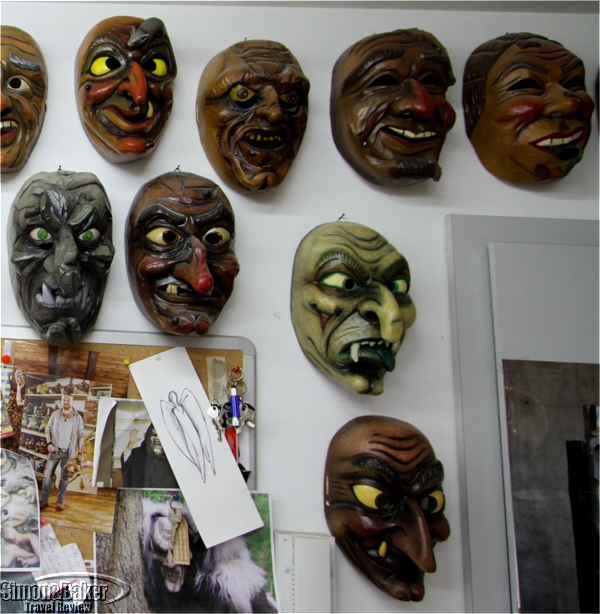
The artist makes masks for groups, collectors, actors and special orders.
Custom masks usually require three days, he explained. During that time he carves the mask by hand and his wife, Lillian Stiegeler, paints it. In his shop there were also modern wood carved souvenirs, especially wooden angels called flügelwesen, as well as Blackest-Forest, a house line of Black Forest themed souvenirs.








